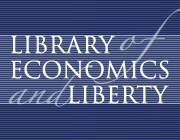
Roy F. Harrod |

Harrod introduced the concepts of warranted growth, natural growth, and actual growth. The warranted growth rate is the growth rate at which all saving is absorbed into investment. If, for example, people save 10 percent of their income, and the economy's ratio of capital to output is 4, the economy's warranted growth rate is 2.5 percent (10 divided by 4). This is the growth rate at which the ratio of capital to output would stay constant at 4.
The natural growth rate is the rate required to maintain full employment. If the labor force grows at 2 percent per year, then to maintain full employment, the economy's annual growth rate must be 2 percent.
Harrod's model showed that two kinds of problems could arise with growth rates. The first was that actual growth was determined by the rate of saving and that natural growth was determined by the growth of the labor force. There was no necessary reason for actual growth to equal natural growth and, therefore, no inherent tendency for the economy to reach full employment. This problem resulted from Harrod's assumptions that the wage rate is fixed and that the economy must use labor and capital in the same proportions. But most economists now believe that wage rates can fall when the labor force increases, although they disagree about how quickly. And virtually all mainstream economists agree that the ratio of labor and capital that businesses want to use depends on wage rates and on the price of capital. Therefore, one of the main problems implied by Harrod's model does not appear to be much of a problem after all.
The second problem implied by Harrod's model was unstable growth. If companies adjusted investment according to what they expected about future demand, and the anticipated demand was forthcoming, warranted growth would equal actual growth. But if actual demand exceeded anticipated demand, they would have underinvested and would respond by investing further. This investment, however, would itself cause growth to rise, requiring even further investment. Result: explosive growth. The same story can be told in reverse if actual demand fell short of anticipated demand. The result then would be a deceleration of growth. This property of Harrod's growth model became known as Harrod's knife-edge. Here again, though, this uncomfortable conclusion was the result of two unrealistic assumptions made by Harrod: first, companies naïvely base their investment plans only on anticipated output, and second, investment is instantaneous. In spite of these limitations, Harrod's lasting contribution was to get economists thinking about the causes of growth as carefully as they had thought about other issues.
Harrod was a close colleague and official biographer of Keynes. The Life of John Maynard Keynes was a second, and only slightly less theoretical, product of Harrod's long association with Keynes.
Born in Norfolk, England, Roy Harrod graduated from New College, Oxford. After spending a term at King's College, Cambridge, where he came in contact with Keynes, Harrod returned to Oxford to administer and teach at Christ Church College until his retirement in 1967. Assar Lind-beck, the chairman of the Nobel Prize Committee, wrote that Harrod would have been awarded a Nobel Prize if he had lived longer. The backlog of other economists awarded the Nobel Prize caused Harrod to miss getting it.
"An Essay in Dynamic Theory." Economic Journal 49 (March 1939): 14-33.
The Life of John Maynard Keynes. 1951.
Towards a Dynamic Economics: Some Recent Developments of Economic Theory and Their Application to Policy. 1948.
The Trade Cycle: An Essay. 1936.
